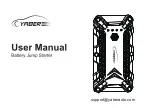
5.0 Operation
47
© 2020 Sensata Technologies
5.2
Operating the Inverter/Charger
5.2.1 Inverter
Mode
Turning the inverter on:
Press the ON/OFF INVERTER button to activate
the inverter function. The inverter will either be actively “inverting” by
using power from the batteries to power the AC loads; or, the inverter will
be “searching” for a load by using very little power from the batteries, if
in Search mode. The green INV LED is on when the inverter is actively
inverting, and
fl
ashes while searching.
Turning the inverter off:
While the inverter is actively inverting or
searching, press the ON/OFF INVERTER button to switch the inverter function
off. This will turn the green INV LED off.
Inverter Standby
– The inverter is a slave unit in a parallel stacked system.
Inverter Standby occurs when the inverter is enabled (green INV LED is on),
but not actively providing power from the batteries to the inverter loads.
During Inverter Standby mode, the loads connected to the inverter are
powered by the other inverters in the parallel stacked system. The standby
inverter will come on automatically if the AC loads increase and require more
inverter power.
5.2.2 Charger
Mode
Turning the charger on:
The Charge mode is automatically activated and
begins when acceptable AC power (utility or generator) is connected to the
input of the inverter. When in Charge mode, the display may show:
Absorb
Charging, Bulk Charging
,
Charger Standby
,
Charging
,
Equalizing
,
Float
Charging
,
Full Charge, Load Support AAC, Load Support VDC, and Silent
.
Charger Standby
– While the charger is actively charging, press the ON/
OFF CHARGER button to switch the charger to Charger Standby. While in
Charger Standby, the incoming AC is still available on the inverter’s output,
but the charger is not allowed to charge. The LCD displays “
Charger Standby”
and the CHG LED
fl
ashes.
Info:
To resume charging, press the ON/OFF CHARGER button or
disconnect/reconnect AC power to the inverter’s input.
Equalize charging:
Equalizing is a “controlled overcharge” performed after
the batteries have been fully charged. It helps to mix the battery electrolyte
(to reverse the buildup of strati
fi
cation) and to remove sulfates that may
have built up on the plates. These conditions if left unchecked, will reduce
the overall capacity of the battery. To enable the Equalization charge, see the
information on page 51.
WARNING:
Do not perform an Equalize charge without reading and
following all safety precautions pertaining to charging/equalization
as noted in this manual and provided by the battery manufacturer,
and any equalization information in the inverter owner’s manual.
CAUTION:
Ensure your batteries can be equalized—only equalize
your batteries if permitted by your battery manufacturer. Performing
an Equalize Charge on batteries other than liquid lead acid or certain
AGM types could permanently damage them. Refer to your battery
manufacturer on how to properly equalize your batteries.
Info:
Equalization charging is not available if GEL, AGM2, or LFP is
selected under the SETUP menu’s
04 Battery Type
menu.
















































